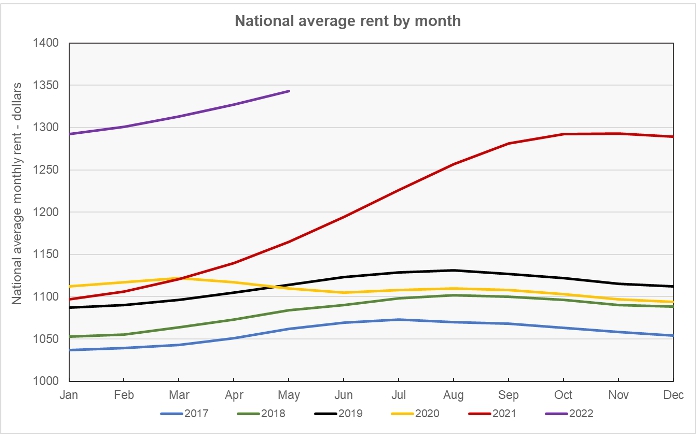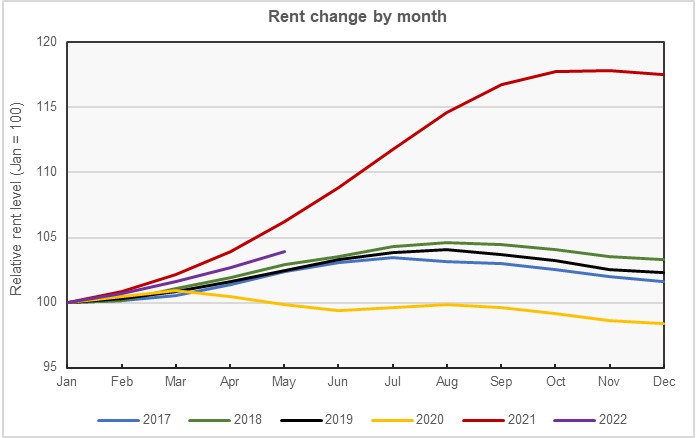The latest rent report from Apartment List shows that the national average rent rose in May. Rent growth was 1.2 percent month-over-month and 16.4 percent year-over-year.
The history of rent changes for the 6 years for which Apartment List has data is shown in the first chart, below. Rents in May were at an all-time high.

The pattern of rent growth
Rents usually rise in the spring and that pattern is holding true this year. This is illustrated in the next chart, below, which shows how rents change throughout the year. This chart normalizes the rent in each year to a value of 100 in January so that the annual patterns of growth can be more directly compared.

The chart shows that the pandemic year of 2020 and the recovery year of 2021 both deviated from the pattern of rent growth seen in 2017 through 2019. So far, rent growth in 2022 is following a track closer to those of the pre-pandemic years than those of the last two years. However, the rate of rent growth seen in 2022 up to this point is running somewhat ahead of the rates seen in pre-pandemic times. Year-to-date rent growth in 2022 is nearly 4 percent while the rate of rent growth in the pre-pandemic years through May ranged from 2.4 percent to 3.0 percent.
New data from Apartment List suggests that the national average vacancy rate did not decline last month as originally reported. They now report that the vacancy rate has been rising since last October and has reached a rate of 5.0 percent. The start of the rise in the vacancy rate coincided with the break in the rapid rise in rents last year.
Leaders and trailers
Apartment List provides the underlying data they collected in compiling their report and that data was used to create the tables, below. The tables look at the 52 metropolitan statistical areas defined by the US Census Bureau with populations over 1 million and identify the top and bottom 10 metros for year-over-year rent growth. The tables provide the average monthly rent in the metro, the annual percentage change in rent (YoY Metro) along with the percentage change from the prior month’s rent level (MoM Metro). They also list the percentage change in rent for the metro area compared to the rent level in February 2020, right before the pandemic struck (Feb 20).
The first table shows the 10 metros with the largest annual rent percentage increases. None of these metros saw its rent fall month-over-month in May.
| Metro | Metro Rent | YoY Metro | MoM Metro | Feb 20 |
| Miami | $2,040 | 27.7 | 0.9 | 35.8 |
| Orlando | $1,658 | 26.4 | 1.5 | 31.5 |
| Tampa | $1,679 | 24.4 | 0.8 | 40.4 |
| Nashville | $1,470 | 20.9 | 1.5 | 25.2 |
| San Diego | $2,316 | 20.3 | 2.0 | 29.0 |
| Tucson | $1,305 | 19.7 | 0.5 | 35.1 |
| Raleigh | $1,500 | 19.7 | 1.6 | 29.1 |
| Austin | $1,654 | 19.3 | 0.9 | 25.0 |
| Phoenix | $1,634 | 19.3 | 0.3 | 34.4 |
| Las Vegas | $1,566 | 19.3 | 0.8 | 34.4 |
The next table shows the 10 metros with the smallest annual rent increases. None of these metros saw its rent fall month-over-month in April.
Of the 52 metros with populations over 1 million, only San Francisco (-1.9 percent) still has average rent levels that are below those from February 2020.
| Metro | Metro Rent | YoY Metro | MoM Metro | Feb 20 |
| Minneapolis | $1,255 | 5.9 | 0.7 | 4.8 |
| Pittsburg | $991 | 7.6 | 2.3 | 11.5 |
| San Francisco | $2,129 | 9.4 | 0.7 | -1.9 |
| Kansas City | $1,164 | 9.5 | 1.5 | 15.9 |
| St Louis | $1,095 | 9.6 | 1.2 | 14.3 |
| Detroit | $1,159 | 9.7 | 101 | 19.2 |
| Sacramento | $1,771 | 10.2 | 0.9 | 25.7 |
| Baltimore | $1,624 | 10.3 | 1.1 | 18.2 |
| Houston | $1,278 | 10.7 | 0.5 | 12.0 |
| Milwaukee | $1,104 | 10.8 | 1.5 | 16.7 |
The complete Apartment List report covers many more metros. It also provides readers with the opportunity to download their data sets. It can be found here.












